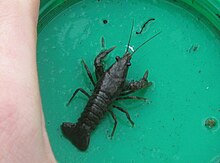Faxonius virilis
| Faxonius virilis | |
|---|---|

| |
| Scientific classification | |
| Domain: | Eukaryota |
| Kingdom: | Animalia |
| Phylum: | Arthropoda |
| Class: | Malacostraca |
| Order: | Decapoda |
| Suborder: | Pleocyemata |
| Family: | Cambaridae |
| Genus: | Faxonius |
| Species: | F. virilis
|
| Binomial name | |
| Faxonius virilis (Hagen, 1870)[3]
| |
| Synonyms[4] | |
| |
Faxonius virilis is a species of crayfish known as the virile crayfish, northern crayfish, eastern crayfish, and lesser known as the lake crayfish or common crawfish. Faxonius virilis was reclassified in August 2017, and the genus was changed from Orconectes to Faxonius.[4] It is native to the central United States, east to tributaries of Lake Erie, Lake Ontario, Lake Champlain and the St. Lawrence River in New York[5] and to much of Canada.[1][2]
Ecology
[edit]Faxonius virilis can be found under stones and logs in lakes, streams, and wetlands, where they hide from predators, such as fish. They are identified by the brown of rust-red carapace and large chelipeds, which are usually blue in colour. Faxonius virilis feeds on a wide range of plants and invertebrates, as well as tadpoles and even small fish.
Distribution
[edit]
Faxonius virilis is found in southern Canada from Alberta to Quebec and in the northern United States,[2] but has become an invasive species in parts of North America outside its native range, and was discovered in the United Kingdom in 2008.[6] It is listed as a species of Least Concern on the IUCN Red List.[1]
Invasive status
[edit]In Europe, Faxonius virilis is included since 2016 in the list of Invasive Alien Species of Union concern (the Union list).[7] This implies that this species cannot be imported, bred, transported, commercialized, or intentionally released into the environment in the whole of the European Union.[8]
Uses
[edit]Faxonius virilis is used as fishing bait and as food for humans, and also as aquarium food for carnivorous fish.[9]
References
[edit]- ^ a b c Adams, S.; Schuster, G.A. & Taylor, C.A. (2010). "Orconectes virilis". IUCN Red List of Threatened Species. 2010: e.T153831A4551026. doi:10.2305/IUCN.UK.2010-3.RLTS.T153831A4551026.en. Retrieved 25 August 2023.
- ^ a b c "Faxonius virilis". NatureServe Explorer An online encyclopedia of life. 7.1. NatureServe. Retrieved 16 October 2022.
- ^ "Faxonius virilis". Integrated Taxonomic Information System. Retrieved October 20, 2010.
- ^ a b Keith A Crandall & Sammy De Grave (2017). "An updated classification of the freshwater crayfishes (Decapoda: Astacidea) of the world, with a complete species list". Journal of Crustacean Biology. 37 (5): 615–653. doi:10.1093/jcbiol/rux070.
- ^ Durland Donahou, A. (24 July 2019) [Peer reviewed on 13 November 2017]. "Faxonius virilis (Hagen, 1870)". Nonindigenous Aquatic Species. Gainesville, Florida: U.S. Geological Survey. Retrieved 25 August 2023.
- ^ Daniel Ahern; Judy England & Adam Ellis (2008). "The virile crayfish, Orconectes virilis (Hagen, 1870) (Crustacea: Decapoda: Cambaridae), identified in the UK". Aquatic Invasions. 3 (1): 102–104. doi:10.3391/ai.2008.3.1.18.
- ^ "List of Invasive Alien Species of Union concern - Environment - European Commission". ec.europa.eu. Retrieved 2021-07-27.
- ^ "REGULATION (EU) No 1143/2014 of the European parliament and of the council of 22 October 2014 on the prevention and management of the introduction and spread of invasive alien species". Official Journal of the European Union. 57 (L 317): 35–55. 4 November 2014. Retrieved 26 August 2023.
- ^ Krista Kagume (2008). Ontario Nature Guide. Edmonton: Lone Pine Publishing. ISBN 978-1-55105-564-0.
External links
[edit]- "UK Crayfish Website". Buglife – The Invertebrate Conservation Trust. Archived from the original on 2020-10-25. Retrieved 2012-01-26.
- "USGS Nonindigenous Aquatic Species – Virile Crayfish". US Geological Survey.


